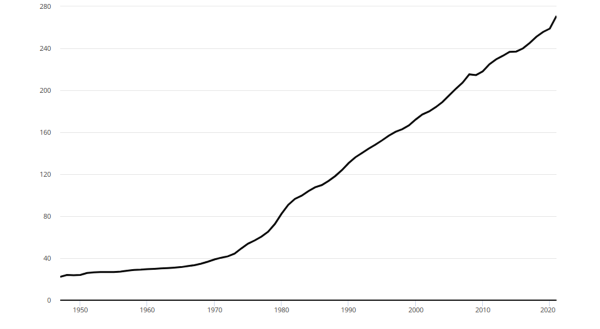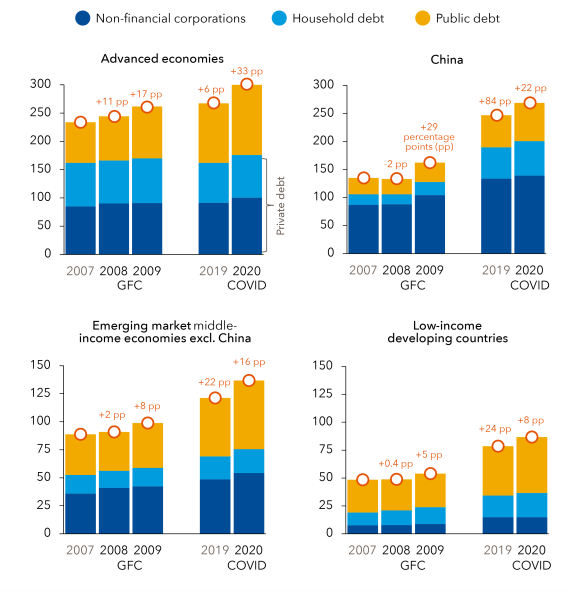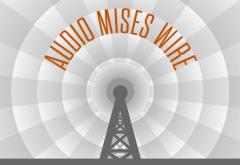(The following text is a revised update of an article that was first published in 2005.) The recent outbreak of price inflation with the jump to an annual rate of 8.6 percent in May 2022 came as a surprise to the US central bank (the Federal Reserve). Having ignored the warnings of the Austrian school economists, the policy makers were paralyzed in the face of a phenomenon they deemed impossible to happen. None of their forecasting models had triggered an inflation alert. Central Banks Don’t Fight Inflation Failing to apply countermeasures in time, the Fed is now faced with the hard job of bringing down the price inflation rate without causing a recession. Prolonged stagflation may characterize the next decade. Are we back in the 1970s? During the stagflation at
Topics:
Antony P. Mueller considers the following as important: 6b) Mises.org, Featured, newsletter
This could be interesting, too:
Nachrichten Ticker - www.finanzen.ch writes Die Performance der Kryptowährungen in KW 9: Das hat sich bei Bitcoin, Ether & Co. getan
Nachrichten Ticker - www.finanzen.ch writes Wer verbirgt sich hinter der Ethereum-Technologie?
Martin Hartmann writes Eine Analyse nach den Lehren von Milton Friedman
Marc Chandler writes March 2025 Monthly
(The following text is a revised update of an article that was first published in 2005.)
The recent outbreak of price inflation with the jump to an annual rate of 8.6 percent in May 2022 came as a surprise to the US central bank (the Federal Reserve). Having ignored the warnings of the Austrian school economists, the policy makers were paralyzed in the face of a phenomenon they deemed impossible to happen. None of their forecasting models had triggered an inflation alert.
Central Banks Don’t Fight Inflation
Failing to apply countermeasures in time, the Fed is now faced with the hard job of bringing down the price inflation rate without causing a recession. Prolonged stagflation may characterize the next decade. Are we back in the 1970s? During the stagflation at that time, Arthur Burns was the chairman of the Federal Reserve. After having left his job in 1978, he held an alarming speech at the meeting of the International Monetary Fund in Belgrade, on September 30, 1979. His presentation bore the title “The Anguish of Central Banking.” In his talk, the former chairman of the American Federal Reserve explained why central banking and price inflation go hand in hand.
In his presentation, Burns offered little hope for an escape from secular inflation. Current worldwide philosophical and political trends, Burns diagnosed, would continue to undermine wealth creation. These modern cultural trends spilled over to politics, produced permanent budget deficits, and introduced “a strong inflationary bias” (p. 13) into the economy.
Reviewing central bank action in the 1960s and 1970s, Burns stated in his speech that “viewed in the abstract, the Federal Reserve System had the power to abort the inflation at its incipient stage fifteen years ago or at any later point, and it has the power to end it today. At any time within that period, it could have restricted money supply and created sufficient strains in the financial and industrial markets to terminate inflation with little delay. It did not do so because the Federal Reserve was itself caught up in the philosophic and political currents that were transforming American life and culture” (p. 15).
Modern central banks lack the stamina to fight inflation in a consistent way. They may try to curb the inflationary pressure, but “by and large,” monetary policy has fallen under the spell of being “governed by the principle of under nourishing the inflationary process while still accommodating a good part of the pressures in the marketplace.” Burns explained that it is the same in other parts of the world where almost all modern central banks are functioning basically in a similar political environment, and thus behave in the same fashion leading to the “anguish of central banking” (p. 16).
Central banks are not only hostages of their political environment, but they are also technically and intellectually not up to their job. Central bankers make errors and encounter surprises “at practically every stage of the process of making monetary policy” (p. 18); misinterpretations of statistics abound, and there is also no reliable scientific guide for central banking: “Monetary theory is a controversial area. It does not provide central bankers with decision rules that are at once firm and dependable” (p. 17).
Burns ended his speech by saying:
My conclusion that it is illusory to expect central banks to put an end to the inflation that now afflicts the industrial democracies does not mean that central banks are incapable of stabilizing actions; it simply means that their practical capacity for curbing an inflation that is continually driven by political forces is very limited. (p. 21)
Secular Price Inflation
What has changed since then? Are central banks up to their job by now? Have they learned how to interpret statistics correctly? Have they gained true independence? A superficial answer may say, “Yes.” Paul Volcker came in 1979 as the successor to G. William Miller (who replaced Burns in 1978) and Volcker put the foot on the brakes, wiped out inflationary expectations, and opened the door to decades of stability. Then came Alan Greenspan to carry on and brought modern central banking to its current epitome.
In a more realistic assessment, however, the answer is that not much has really changed. Inflation seems to be more benign nowadays, but it is a harsh twist of words to say price stability has been achieved when, since 1980, the official price index has doubled. Central bankers still meet surprises “at practically every stage of the process of making monetary policy”, and modern interventionist academic monetary theory has actually contributed very little “to provide central bankers with decision rules that are at once firm and dependable”.
| Seen from a long-term historical perspective, we still live in an inflationary age, and the turning point for the US can be clearly defined in 1914 when the US central bank began to operate. It took only a couple of years for the newly created Federal Reserve System to finance the American entry into World War I and to create an inflationary boom in the 1920s that prepared the way for the deflationary period during the Great Depression in the 1930s. After the Second World War, prices began their steady rise again, first slowly, then, since the early 1970s, in an accelerated way (figure 1).
Since abandoning the gold standard after the Smithsonian agreement of December 1971, the American people entrust the central price of the modern economy—the interest rate—to governmental bureaucrats for them to manipulate. Presumably, they know what they are doing, and they are doing it for the best of the country. Yet the facts speak against this presumption. After a short period of forcefully curbing the money supply in the late 1970s—more by accident in its impact than by deliberate design—the US central bank has turned into a debt machine that inundates the government, households, companies, and the globe with dollars. The success of the monetary policy in 1979/1980 of dampening the inflation and wiping out inflationary expectations was mainly due to a false estimation of the future growth of the velocity of money. Paul Volcker, then chairman of the Federal Reserve, wanted to curb inflation, but he did it in this swift form largely inadvertently, by squeezing the money supply at an amount consistent with a supposedly rising velocity of money circulation. As it turned out, the velocity of circulation had—contrary to expectations—slowed down. Thereby, the intended “gradualist approach” had become a much more radical monetary experiment than planned (see p. 169 in Changing Fortunes: The World’s Money and the Threat to American Leadership). |
|
Incessant Debt CreationGlobal debt creation has been going on at an unprecedented pace, and the major players in this game are the central banks under the obvious or implicit tutelage of their governments to whom they own their jobs (figure 2). A paradoxical situation has arisen. The monetary system of a fiat standard entails an internal mechanism to drive toward debt creation. At first, central banks provide liquidity that allows debt accumulation. Then, because of the rise of the debt burden, central banks become reluctant to raise the interest rates and curb the debt expansion as they fear the negative consequences for the financial markets and their impact on the economy. Over the past decades, several situations happened when the leading central banks refrained from continuing with a restrictive policy because the stock and bond markets came under stress. Equally problematic is the case of the European Central Bank. Although the inflation rate in the euro area has risen to over 8 percent in May 2022, the ECB has remained reluctant to raise the interest rate. Led by its chairwoman, Christine Lagarde, the European Central Bank rather lets the debt growth continue and the price inflation rise than risk debt service problems of the highly indebted countries in the south of eurozone along with France. Modern central banks will do little other than to “under nourish” the trend toward inflation—when they are good at their job and helped by some luck. Faced with the serious choice between putting serious strain on the financial markets and industry to terminate inflation or letting the boom go on beyond control, they will opt for the latter. In the current institutional setting, it is the natural tendency of central banks to produce unsustainable booms first and prolong the inevitable slump in the aftermath. |
In Human Action, Ludwig von Mises put the problem this way: “Credit expansion is the government’s foremost tool in their struggle against the market economy. In their hands it is the magic wand designed to conjure away the scarcity of capital goods, to lower the rate of interest or abolish it altogether, finance lavish government spending, expropriate the capitalists, contrive everlasting booms, and make everybody prosperous”—with the consequence that such an artificial boom inexorably will lead to the bust.
In this perspective, it seems an idle game to expect better central bankers or improved analytical tools, or more reliable econometric models. The right way to look for an escape is to move toward different institutional settings. Main proposals to dissolve the monopolistic structure of central banking include the “denationalization of money” and letting free banking flourish, to establish a modern gold standard or the concept of a bitcoin standard. All these schemes aim at attacking the problem of establishing a limit to monetary expansion. This way, freezing the stock of the monetary base also needs to be discussed as a solution to permanent debt creation.
Conclusion
Registered inflation rates have been somewhat subdued in the 1980s, but inflation certainly is not “dead”, and the inflationary age has not yet ended. It will not end as long as central banks and governments hold the lever to create money more or less at will. No less so when Arthur Burns practiced central banking, the interventionist policies of today’s central banks lack a reliable basis in monetary theory, diagnostic errors abound, and the inherent inflationary bias of central banks is still alive. While seemingly benign for some time, price inflation has come back with a vengeance.
Tags: Featured,newsletter










